

Discover more from Israel from the Inside with Daniel Gordis
"What was shocking about the tunnel video was what we didn't see in it."
Veteran Israeli journalist Sima Kadmon expressed the views of many (but not all) in a YNet column shortly after the IDF released video footage of the tunnel where six hostages were killed.
This weekend’s newspaper ads in favor of a hostage deal were different than they’d been. Until now, for just about eleven months, these ads have spoken about פדיון שבויים, pidyon shevuyim, the commandment of “redemption of hostages.” Now it’s different. This weekend, in light of the murder in cold blood of six hostages the week before last, the ads were also about פיקוח נפש, piku’ach nefesh, “the obligation to save a life,” which in Jewish law trumps just about all other religious obligations and prohibitions.
Here’s one example (the photograph is intentionally blurred … the point is that the hostages’ lives are gradually fading away ….):
The words at the top are a quote from the Talmud, Sanhedrin 73a (Sefaria translation):
From where is it derived that one who sees another drowning in a river, or being dragged away by a wild animal, or being attacked by bandits [listin], is obligated to save him? The Torah states: “You shall not stand idly by the blood of another.”
The words at the bottom read:
The voice of our captive sisters’ and brothers’ blood calls out to us from Gaza. It’s not just a matter of redeeming hostages, but of saving lives, which is a higher command than the entire Torah.
Just as the shiva for the six murdered hostages had concluded, their families and all of Israel were thrust back into moments of horror when the IDF released video footage of the tunnel in which they had been held, and then murdered.
The video above is a shortened version of what was presented to the Israeli public in Hebrew. The Hebrew version, which was longer and more detailed, was more powerful, but the horror of the place and what happened there is evident even here.
Last week, we presented an argument by Dr. Einat Wilf who argued that there is no reason to believe that a hostage deal is even possible. She might well be right. But that “truth” can coexist with other “truths” felt by many Israelis, namely, that whether or not Hamas will ever agree to a deal, the way that the government is dealing with the hostage families is a horror of a different sort.
Below, an AI-generated translation of parts of a column from September 9 by Sima Kadmon, a veteran Israeli journalist who’s been writing about politics for decades. Kadmon, widely regarded as a very serious journalist, served in the air force in Squadron 201 in the early 1970s, including during the Yom Kippur War. Relatively recently, she was instrumental in creating a superb docuseries on Kan 11 TV that discusses the very complex history of that Squadron and what happened in the 1973 war. ( Unfortunately, to my knowledge, the series (IMDb site is here) has not been translated into English yet.)
Kadmon doesn’t argue against Wilf’s claim that a deal isn’t possible. She doesn’t claim to know whether one is or isn’t. What she does claim to know is something else entirely. And because what she writes is such a widely held view, we share it to give our readers a sense of the rising waters of frustration that may—or may not—lead to a demand for change.
SUNDAY (today, 09/15): Veteran Israeli journalist Sima Kadmon reflects on the frustration and rage of many Israelis following release of the video of the tunnel where six hostages were held and murdered.
MONDAY (09/16): Repairing broken souls is going to be an Israeli priority for as far as the eye can see. Since the beginning of the war, we’ve seen Israelis of all walks of life take responsibility for turning personal tragedy into ways of helping others. Gal Nissim-Emanuel, in the wake of her brother’s death long before the war, did the same thing, building her own organization to combat the problem of suicide in Israeli life. We share her story and work in a podcast available to everyone.
TUESDAY (09/17): “When the Heart Cries,” a now classic Israeli song by Sarit Hadad, has taken on new meaning in post-October 7 Israel. We share the song, a new duet of the song, and a video of former hostage Moran Stella Yanai speaking to Sarit Hadad about hearing her song in captivity.
WEDNESDAY (09/18): With our hearts heavy and cracked, what should we feel, how should we think when the holidays arrive in just a few weeks. Rabbi Joe Wolfson leads a vibrant, inspiring Orthodox community of largely Anglos in Tel Aviv. In this week’s podcast, we find out from him about the burgeoning English-speaking college scene in Tel Aviv, his unique community’s engagement with secular kibbutzim and a Bedouin family, and his thoughts about how we can shape our hearts and minds in advance of holidays that are going to be challenging.
THURSDAY (09/19): Much has been written about the crisis in which progressive American rabbis find themselves, having been largely abandoned by the progressive partners they once thought they had. I discussed this (and more) with Rabbi David Ingber of Romemu in New York city early in the war, at the 92nd Street Y. The “Y” just made our conversation available on YouTube, so we’re reposting it here with some thoughts about how our collective thinking might have changed in the months that have ensued.
What was shocking in the video from the tunnels is actually what wasn't seen in it. One can feel the humidity. The unbearable smell. The walls that close in on you more each day. You can imagine them lying side by side; you can almost hear their whispered conversations during sleepless nights, filled with the fear of death. Four men and two women. Young people with families, loves, and dreams. Who almost, almost escaped.
What was shocking in the video revealed yesterday by the IDF spokesperson is precisely what was not seen in it. What needed to be imagined to fill the gaps, to tell ourselves the whole story. Because alongside what was indeed there—a narrow, low tunnel that cannot be stood in, bottles of urine, women’s hygiene supplies, a cesspit, bloodstains, magazines, and cartridges of Kalashnikovs—what in no way relented were the thoughts of what was happened there, in the narrow passage tunnel where six hostages stayed for almost a whole year.
Without much effort, one could feel the humidity. The lack of air. The unbearable stench. The walls that close in on you more each day. And you can imagine them lying side by side, occasionally someone gets up to move their legs. You can almost hear their whispered conversations during the long daylight hours, during sleepless nights. Filled with the fear of death. How every time someone else took on the role of encouraging, breathing life into their beleaguered souls. Seeking ways to maintain their sanity.
For what we did not see in the video yesterday was four men and two women. Young people with families, loves, dreams. And we can’t escape the thoughts about the conditions in which they were held for eleven months, and how they were almost saved. And that’s what’s so gripping about the video—the story that wasn’t told. The conversations that weren’t heard. The last moments of their lives. Did they know in those seconds, as two terrorists shot them one after the other, that it was going to happen? Did they believe that after everything they’d been through, that this was going to be their end?
After the release of the video, there was no doubt left: the goal of the hostages’ families, the Minister of Defense, and the Chief of Staff was to shock. But not to shock those who are already shocked … Their aim was to shock the cabinet members. And they probably know why it is now necessary to employ the heaviest artillery at their disposal, so that perhaps something will move.
The need to present the video to the cabinet is further proof of the frustration felt by the military leadership in the face of the indifference of the government ministers. In face of the Prime Minister’s insensitivity. They feel the urgency. The need to hurry. The immediate need to reach a deal and free the 101 hostages still in Gaza under similar conditions. …
They, like all of us, saw the visit of Sara and Benjamin Netanyahu to the Danino family’s home, and heard the words of Elhanan, the father of the hostage Uri Danino who was murdered last week. They heard the truthful words of Rabbi Danino—who can hardly be accused of being a leftist, or having a desire to overthrow the government, or being part of the protest movement.
It seems that the condolence visit was intended, as always, to be about them. About Netanyahu, who again recalled the story of the Sabena airplane, and how at the age of 22 he burst in to save the hostages and was injured, and how he lost his brother a few years later. Evidently, it needed to be a member of a bereaved family, a Mizrahi and a Shas person, who does not belong to the elite, to finally say to Netanyahu what should have been said to him a long time ago: “Enough already. You have built a career on the back of your brother.”
.…
The attempts to form a unity government, which began with a post written by Matan Kahana and continued with President Herzog’s proposal calling for Lapid, Gantz, and Lieberman to stand together with Netanyahu to bring the hostages home, have so far failed to convince Netanyahu. As long as he believes he can politically survive, he intends to keep Ben-Gvir and Smotrich in his coalition, even at the cost of returning the hostages.
….
As countless commentators have noted in the past few weeks, a deal might be possible and a deal might not be possible. The crisis of morale in which much of Israel finds itself, though, stems not just from the horror of the hostages, but also from the fact that even if a deal is not possible, Netanyahu is so distrusted at this point that few will believe he really tried.
Where that rage and frustration will lead, we do not yet know.


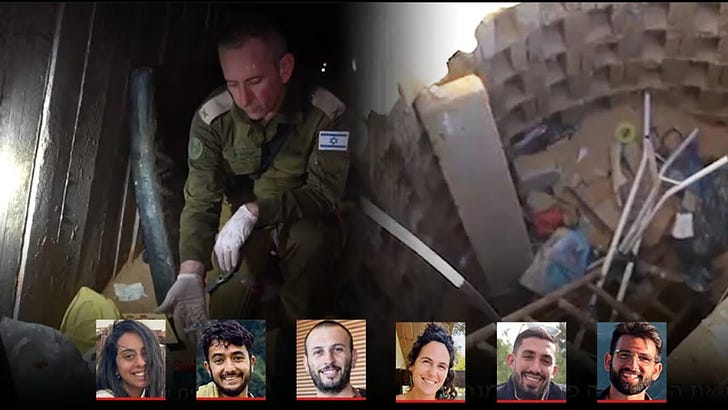




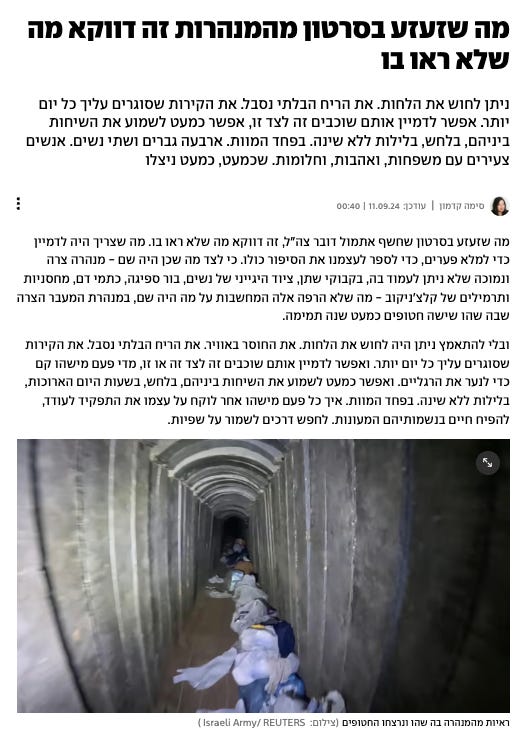
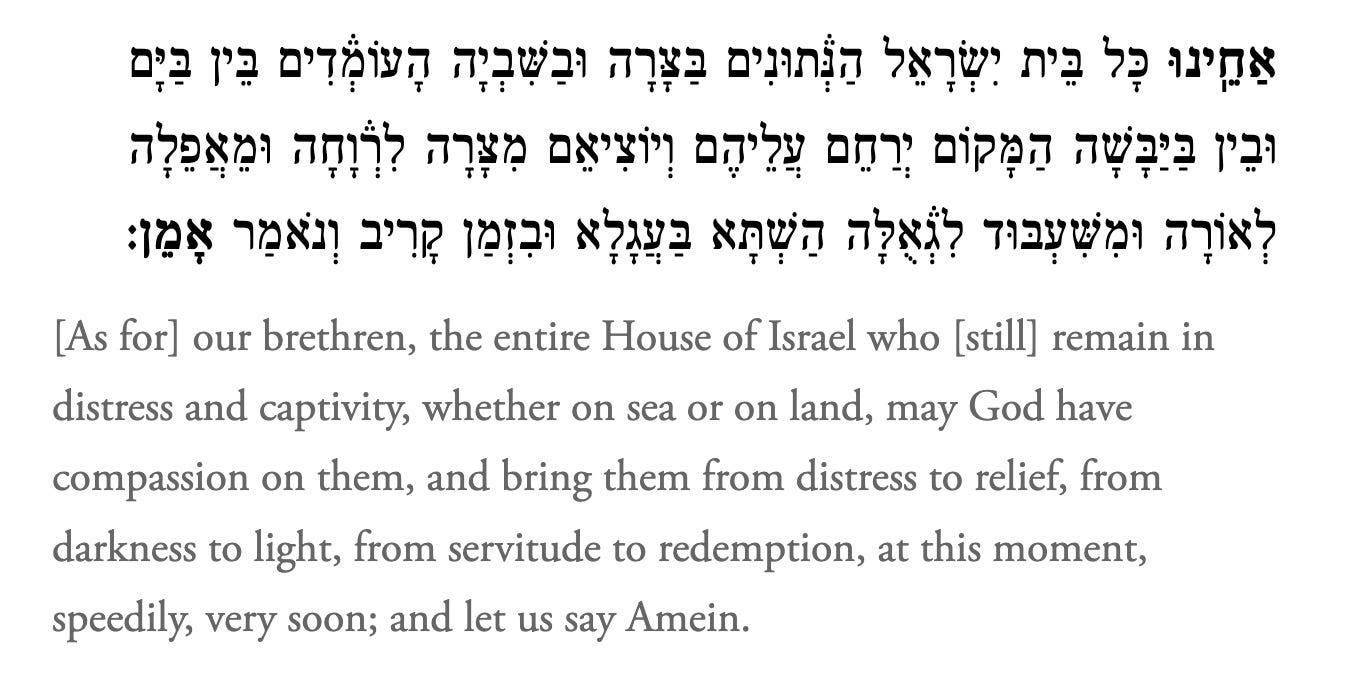





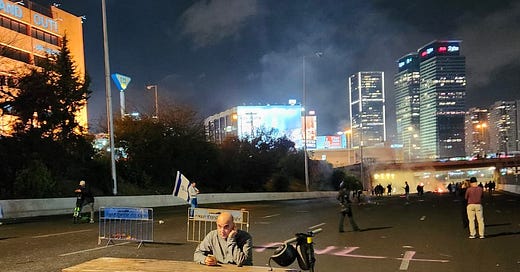

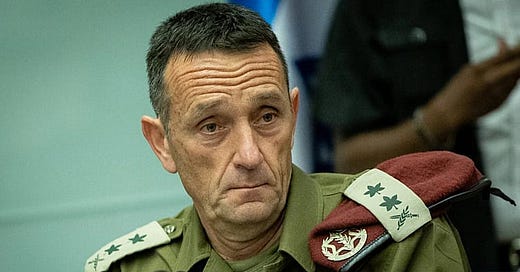



I watched the longer version of the video on YouTube. can't speak as an Israeli - I haven't earned that right. But as another human being, I want to howl from the depths of my soul. How can anyone think that Hamas are freedom fighters or what they are doing is legitimate resistance? Whether there is a deal to be had - I don't know. Can you trust a deal with the devil? But. My God, you have to try.
Bibi, the man everyone loves to hate especially in Israel and Washington, D.C. Yet name another leader who could have navigated the Jewish State through the Scylla and Charybdis of the anti-Semitic world in which Israel finds itself. Now more than ever from my view from America Sinwar has fully engaged the Israeli and American Left in a Sisyphean hostage negotiation that will not free the hostages but only prolong the agony.